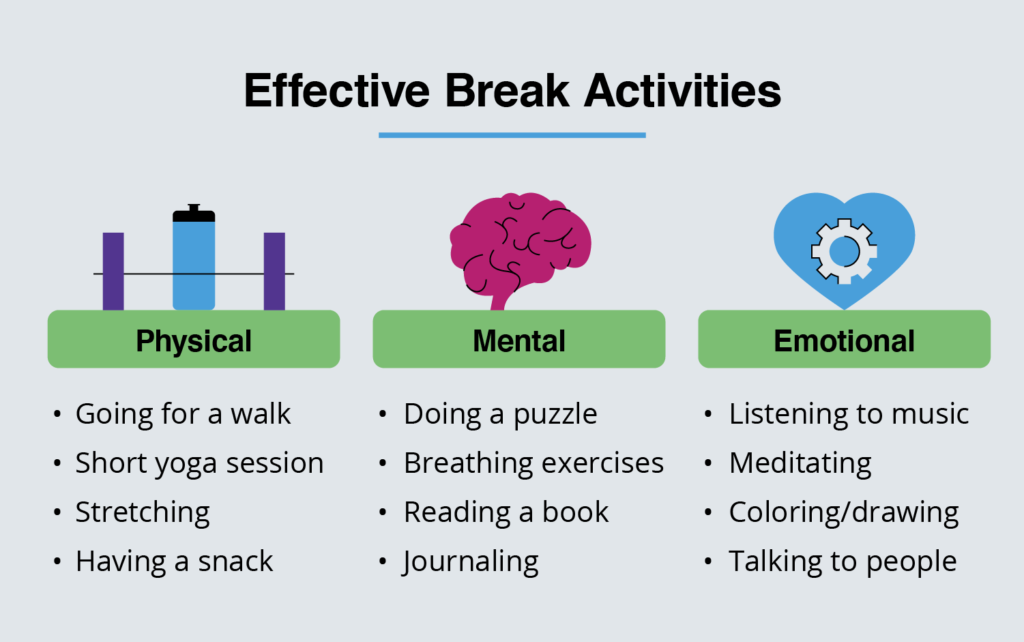Workplace stress usually snowballs. One moment, you’re feeling slightly stressed about an upcoming assignment, and the next, you’re stuck under an avalanche of missed deadlines, unfinished projects, and burnout.
Identifying what makes you feel overwhelmed is the first step to getting out of it and caring for your mental health. From there, you can readjust your workflow or discuss your position with management to make sure you don’t get overwhelmed (and overworked).
Below, we’ve put together eight steps to take when you’re feeling overwhelmed at work.
1. Understand Your Triggers
Before you can successfully combat your feelings of burnout or stress, you should first understand what exactly it is that makes you feel that way. Examine your workload and pinpoint any action items that are pushing you past your limits or are out of scope.
Tip: At the beginning of each week, make estimates for the amount of time each item on your to-do list will take. If the hours are longer than your workweek, consider offloading some work or asking for an extension.

2. Take Breaks
Working straight through an eight-hour workday without a break can quickly become overwhelming. Taking short breaks throughout the workday will help clear your mind and allow you to come back to work with a refreshed mindset. For every few hours of work, take a five to 15-minute break.
Tip: Vary the activities you choose to do on your breaks, picking between physical, mental, and emotional breaks. This means doing things like going for a walk, meditating, eating a quick snack, or doing a puzzle.
3. Ask For Help
If you’re feeling like you have too much work on your plate, it’s not a bad thing to ask for help. Reach out to colleagues to see if they have the bandwidth to assist you. You can also reach out for advice or to troubleshoot any issues you run into.
Tip: Check in with your coworkers about their workload and ability to help before putting something on their plate — you don’t want to overwhelm your coworkers when you feel overwhelmed yourself.
4. Talk to Your Boss
Feelings of stress or workplace anxiety that last longer than one week are a bad sign. So if you feel overwhelmed at work often, it could be a bigger problem. In that case, it’s beneficial to schedule a one-on-one meeting with your boss to discuss your workload and potential solutions for your burnout.
Tip: If possible, come to the meeting with a list of solutions or ideas to solve your workload issues.
5. Create a To-Do List
A to-do list helps you keep track of your workload and decide what to prioritize vs. what can wait. Beyond organization, checking items off of a to-do list can help you feel accomplished and productive. Crossing things off a list helps alleviate feelings of stress as you’re able to see your progress.
Tip: If pen and paper isn’t your speed, there are plenty of virtual tools that you can use to make to-do lists.
6. Meditate or Practice Mindfulness
Meditation and mindfulness practices are proven to combat feelings of stress and anxiety. In fact, a study by students at Michigan Tech showed that just one hour of meditation reduced anxiety in participants. Incorporating meditation and mindfulness practices into your day-to-day life can help combat feelings of stress and anxiety caused by your workload.
Tip: There are many different ways to meditate and apps that can help you get started if you aren’t sure how to begin.
7. Get Microtasks Out of the Way
When you have large tasks on your plate, smaller, uncompleted ones will become stressful. Knocking microtasks out first allows you to focus solely on the bigger picture without being worried about the amount of tasks that are left on your to-do list. This will help improve productivity, reduce burnout, and alleviate feelings of stress and anxiety when you’re overwhelmed at work.
Tip: You can also keep yourself working on something fresh by breaking up larger tasks and completing microtasks every few hours, then returning to your larger project.
8. Set Boundaries
There’s a line between being adaptable and being a pushover. If you’re starting to feel overwhelmed or burnt out, set boundaries about the amount of work you will to take on and how late you will work. If something is put on your plate that crosses those boundaries, or is making you work past your comfortable hours, say no or ask for more time.
Tip: Saying “no” to work that pushes you past your boundaries is scary. You can do so by expressing why you can’t complete the work and offering another solution.
Why Do Workers Feel Overwhelmed?
Many things make people feel overwhelmed at work. Anything from personal life conflicting with work to a large project with a looming deadline can increase feelings of stress.
Some common workplace stressors include:
- Multiple deadlines looming at once
- Large projects
- Lack of support from coworkers or management
- Projects without clear instructions
- Lack of training to complete tasks
You can resolve these these stressors when the project is turned in or by hiring someone new. But, if you continue to feel stressed at work, you should start a conversation about how to maintain a sustainable workload.
Get Support Throughout Your Career
Many things make work stressful, especially for those who work remotely or in a different country than their employer. In those cases, a compliance partner keeps you on track to get paid, receive benefits, and work from anywhere.
Contact us to see how we can help you.




